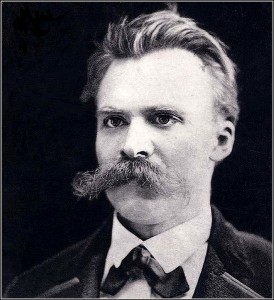Hitler was able to rise to
power in Germany because during this time Germany was suffering greatly and he
offered both a solution and a scapegoat for the problems they had been facing; his
ideals can be described with three adjectives, pernicious, Aryan, and borrowed.
After WWI, the Germans had been forced to accept full responsibility for the
war as well as to pay for all the war’s expenses. Germans had also been appointed
a government by the group at the Paris Peace Treaty (to which they were not
invited). Hitler’s ideals were non-democratic, and non-communist and he gave
Germany someone to blame and a way to fix the problem.
It’s
important to understand that Hitler’s ideals were mostly Fascist, but with a
racist twist. Fascism was originally a bunch of borrowed ideas that were mashed
together by Mussolini, who Hitler borrowed Fascism from. So in this way, Hitler’s
ideas were double borrowed. Hitler also
took many of his ideas from Frederick Nietzsche- going so far as to appoint him
the philosopher of the Reich.
The
ideals of the Nazi party revolve around creating an “Aryan” society which in
Hitler’s mind was the perfect society that would bring Germany back into power.
In this case Aryan meaning of Nordic decent, white, and not Jewish. Because
it is one of the main goals of the Nazi party it’s important to have it in the
list.
Lastly,
Hitler’s ideals were very pernicious. Fascism is already very willingly
violent, and on top of that Hitler had a goal of killing as many Jewish people
as possible, hoping to rid Europe of them.
“I do not want even to
speak of the Jews. They are simply our old enemies, their plans have suffered
shipwreck through us, and they rightly hate us, just as we hate them. We
realize that this war can end only either in the Wiping out of the Germanic
nations, or by the disappearance of Jewry from Europe. On September 3rd I spoke
in the Reichstag--and I dislike premature prophecies--and I said that this war
would not end the way the Jews imagine, that is, in the extinction of the
European Aryan nations, but that the result of this war would be the
destruction of Jewry. For the first time, it will not be the others who will
bleed to death, but for the first time the genuine ancient Jewish law, "an
eye for an eye, a tooth for a tooth," is being applied. “ – Adolf
Hitler
As well, Hitler wanted not to coexist or become more
powerful than the other forms of government but simply wanted to destroy them
all. The Nazi party’s way of dealing with their problems involved causing
everyone who didn’t agree with them harm, destroying them, but because dealing
with their problems and getting back on top was their ultimate goal it made
their ideals pernicious and generally violent.
“For fourteen or
fifteen years I have continually proclaimed to the German nation that I regard
it as my task before posterity to destroy Marxism, and that is no empty phrase
but a solemn oath which I shall follow as long as I live. I have made this confession
of faith, the confession of faith of a single man, that of a mighty
organization. I know now that even if fate were to remove me, the fight would
be fought to the end; this movement is the guarantee for that. This for us is
not a fight which can be finished by compromise. We see in Marxism the enemy of
our people which we will root out and destroy without mercy.... We must then
fight to the very end those tendencies which have eaten into the soul of the
German nation in the last seventeen years, which have done us such incalculable
damage and which, if they had not been vanquished, would have destroyed
Germany. Bismarck told us that liberalism was the pace-maker of Social
Democracy. I need not say here that Social Democracy is the pace-maker of Communism.
And Communism is the forerunner of death, of national destruction, and
extinction. We have joined battle with it and will fight it to the death.”-
Adolf Hitler






